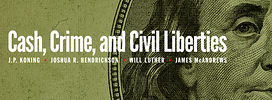The discussion this month by J.P. Koning, Joshua Hendrickson, and William Luther has touched on many issues, too many to address here. I will discuss two difficulties that I see with J.P. Koning’s original proposal to introduce a high-denomination note in the United States and to tax it: First, what evidence do we have that a high-denomination note is needed? Second, is taxing notes of different denominations feasible?
To answer the question behind Koning’s proposal, namely, “Does the United States need a new note of $500 or $1,000 denomination?” requires an empirical investigation. Although the real value of the $100 note has declined over the last several decades as the moderate inflation experienced in the United States has whittled away at its purchasing power, alternative means of payment have been developed during that time. Paying by card or smartphone app is both common and incredibly convenient today, a marked change from a few decades ago. The development of convenient and near-universal electronic payment methods poses a fundamental challenge to the introduction of any new payment method, including a high-denomination note. To determine if a new high-denomination note would be in demand, we must assess the likelihood that it would be used in everyday commerce.
Many people, particularly those who lack bank accounts or smartphones, are poorly served by the modern card and smartphone payment methods. Many of those people are also poor and have highly uneven income. The financial system is not doing a particularly good job of providing them with convenient alternatives to currency. But would a high-denomination note help them? Carrying five $100 notes is only slightly more inconvenient than carrying a single $500 note, so I don’t believe that the provision of a high-denomination note would serve the unbanked’s demands much better than the current set of denominations. This conjecture is supported by survey evidence that most people, including the unbanked population, carry relatively little currency, and primarily of low denominations.
To pursue the proposal of issuing a high-denomination note, I’d first like to see a proposal to gather evidence that such a note would be used. Current surveys do not provide sufficient evidence of the need for a new note. Different types of surveys, such as marketing surveys, would be useful to provide better insight into the question of whether people would welcome the note and use it. For example, would corner grocery stores accept such a note in payment? Many stores currently limit the denominations they accept to a maximum of $20. I would expect that very few stores would accept a $500 note, but rather than speculating about this question, surveys can be designed to measure the potential response of store owners and consumers alike. We need more evidence before we can assess the potential uses of such a note.
The second concern I have with the proposal is its suggestion that the new notes be taxed. While both Koning and Hendrickson suggest ways to tax notes, William Luther and I have emphasized that the tax may fall on many law-abiding citizens as they would use the new notes. Even more fundamentally, I continue to doubt the ability of society to enforce such a tax.
While Koning likens a tax to various demonetizations of currency, reasoning that the demonetizations have feasibly achieved their goals, a tax on notes would seek to decentralize a much smaller reduction in value for notes on a frequently recurring basis. Differential taxation of notes of different denominations is similar to imposing different rates of inflation on the different notes. It would be difficult to communicate and enforce those different rates throughout the economy—stores would have to post the current daily rate of exchange for the high-denomination notes. Peter Garber suggested the best idea for imposing differential costs on note-holders, which was to increase the physical dimensions of high-denomination notes.[1] In that way, anyone who uses such a note is subject to the inconvenience of handling and storing the notes. This would be especially costly to those criminals engaged in the drug trade, who handle vast numbers of notes, and whose storage and handling costs of notes are a significant part of their overall costs of doing business. Although this idea would increase the costs of handling and storing notes, it is not a tax, and raises no revenue for the government. It does highlight, though, the importance of thinking through the details of exactly how a tax would be enacted.
One further objection to a taxed note is that, even were a tax to be perfectly enforced, the differential rates of exchange among the different denominations of notes is an inconvenience. The cost of all those calculations required to make change and set different prices based on which note a customer offers must be counted against whatever benefit a tax might achieve.
The development of card and smartphone methods of payment has been astounding. Those means of payment are convenient and provide many benefits, such as recordkeeping, that aren’t available with currency. These methods have largely substituted for currency as the real value of the U.S. currency’s fixed denominations has declined. However, they don’t replicate all the economic features of currency. Working on expanding the functions of electronic means of payment to mimic those of currency, such as improving privacy protections, is likely a better way to improve our monetary system than to introduce a new high-denomination note. In addition, society should take greater efforts to improve access to the financial system to poor and unbanked populations.
Note
[1] Peter Garber, “A Barbaric Relic,” Book Review, IMF Finance & Development,September 2016, Vol. 53, No. 3.

